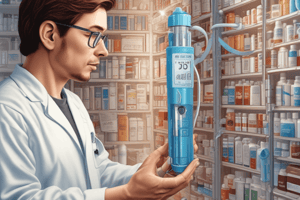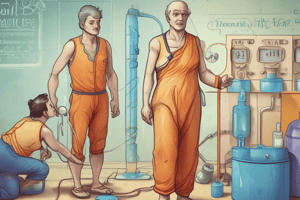Podcast
Questions and Answers
What is the primary goal of maintaining a controlled level of glycosylated Hb (Hb A1c) in DM type 1 therapy?
What is the primary goal of maintaining a controlled level of glycosylated Hb (Hb A1c) in DM type 1 therapy?
- To prevent ketoacidosis
- To maintain acceptable glucose levels (correct)
- To monitor insulin dosage
- To prevent weight gain
What is the main reason for combining non-insulin antidiabetics with insulin in type 2 DM treatment?
What is the main reason for combining non-insulin antidiabetics with insulin in type 2 DM treatment?
- To improve insulin action and insulin supply (correct)
- To reduce insulin dosage
- To prevent weight loss
- To reduce the risk of ketoacidosis
What is the function of C-peptide in the body?
What is the function of C-peptide in the body?
- It stimulates insulin secretion
- It has a mild hypoglycemic action
- It has no known physiologic function (correct)
- It helps regulate blood glucose levels
What is the primary stimulus for insulin secretion from pancreatic B cells?
What is the primary stimulus for insulin secretion from pancreatic B cells?
What is the effect of closing ATP-dependent potassium channels on pancreatic B cells?
What is the effect of closing ATP-dependent potassium channels on pancreatic B cells?
What is the result of deviation from a regular diet in DM type 1 therapy?
What is the result of deviation from a regular diet in DM type 1 therapy?
What is the purpose of administering pramlintide in DM type 1 therapy?
What is the purpose of administering pramlintide in DM type 1 therapy?
What is the usual combination of agents used in type 2 DM treatment after 5 years of secondary failure?
What is the usual combination of agents used in type 2 DM treatment after 5 years of secondary failure?
What effect does insulin have on the degradation of glycogen to glucose?
What effect does insulin have on the degradation of glycogen to glucose?
What is the outcome of insulin's effect on protein breakdown in the muscle?
What is the outcome of insulin's effect on protein breakdown in the muscle?
What is the effect of insulin on glucose transport into skeletal muscle cells?
What is the effect of insulin on glucose transport into skeletal muscle cells?
What is the outcome of insulin's effect on lipolysis in adipose tissues?
What is the outcome of insulin's effect on lipolysis in adipose tissues?
What is the effect of insulin on glucose uptake in skeletal muscle cells?
What is the effect of insulin on glucose uptake in skeletal muscle cells?
What is the effect of insulin on amino acid uptake in skeletal muscle cells?
What is the effect of insulin on amino acid uptake in skeletal muscle cells?
What is the effect of insulin on lipolysis?
What is the effect of insulin on lipolysis?
What is the primary function of insulin in the body?
What is the primary function of insulin in the body?
What is the primary source of insulin for therapeutic uses?
What is the primary source of insulin for therapeutic uses?
What is the characteristic of rapid-acting insulin analogs?
What is the characteristic of rapid-acting insulin analogs?
Which type of diabetes mellitus is caused by the destruction of pancreatic beta cells?
Which type of diabetes mellitus is caused by the destruction of pancreatic beta cells?
What is the primary effect of glucagon on blood glucose levels?
What is the primary effect of glucagon on blood glucose levels?
What is the use of short-acting insulin?
What is the use of short-acting insulin?
What is the result of uncontrolled hepatic glucose output and reduced uptake of glucose by skeletal muscle?
What is the result of uncontrolled hepatic glucose output and reduced uptake of glucose by skeletal muscle?
What is the composition of intermediate-acting insulin?
What is the composition of intermediate-acting insulin?
What is the function of somatostatin in the body?
What is the function of somatostatin in the body?
When is short-acting insulin given?
When is short-acting insulin given?
What is the primary cause of polyuria in diabetes mellitus?
What is the primary cause of polyuria in diabetes mellitus?
What is the effect of insulin on glucose uptake?
What is the effect of insulin on glucose uptake?
What is the use of rapid-acting insulin in emergency situations?
What is the use of rapid-acting insulin in emergency situations?
What is the function of pancreatic polypeptide (PP) in the body?
What is the function of pancreatic polypeptide (PP) in the body?
What is the primary characteristic of Type 2 diabetes mellitus?
What is the primary characteristic of Type 2 diabetes mellitus?
What type of insulin preparation is often combined with a short-acting preparation in patients with DM1?
What type of insulin preparation is often combined with a short-acting preparation in patients with DM1?
What is the primary use of inhaled insulin?
What is the primary use of inhaled insulin?
What is the main complication resulting from excessive insulin effect?
What is the main complication resulting from excessive insulin effect?
What is the primary mechanism of insulin in treating hyperkalemia?
What is the primary mechanism of insulin in treating hyperkalemia?
What is a common immunological complication of insulin therapy?
What is a common immunological complication of insulin therapy?
What is a potential consequence of hypokalemia in acidosis patients treated with insulin and glucose?
What is a potential consequence of hypokalemia in acidosis patients treated with insulin and glucose?
Why do patients with DM2 ultimately require insulin treatment?
Why do patients with DM2 ultimately require insulin treatment?
What is a common adverse effect of insulin therapy that is related to fluid retention?
What is a common adverse effect of insulin therapy that is related to fluid retention?
Flashcards are hidden until you start studying
Study Notes
Clinical Uses of Insulin
- Patients with DM1 require long-term maintenance treatment with insulin.
- An intermediate-acting preparation is often combined with a short-acting preparation taken before meals.
- Soluble insulin is used (i.v.) in emergency treatment of hyperglycemic diabetic emergencies (ketoacidosis).
- Many patients with DM2 ultimately require insulin treatment.
- Short-term treatment of patients with DM2 or impaired glucose tolerance during intercurrent events (operations, infections, myocardial infarction).
Adverse Effects of Insulin
- Hypoglycemia: the most common complication resulting from excessive insulin effect.
- Insulin-induced immunological complications: the most common form is the formation of Abs to insulin or to non-insulin protein content.
- Hypokalemia: may occur in acidosis patients who use a lot of insulin and glucose, leading to patient death with abnormal heart beat.
- Weight gain: due to increased caloric storage of glucose by insulin and some is due to renal sodium retention resulting in fluid retention and edema.
Pancreatic Islet Cells and Their Secretory Products
- Alpha cells secrete glucagon, which opposes many actions of insulin by increasing blood glucose through activation of hepatic glycogenolysis and gluconeogenesis.
- Beta cells secrete insulin, the storage and anabolic hormone of the body, and amylin, which modulates appetite, gastric emptying, and glucagon and insulin secretion.
- Delta cells secrete somatostatin, a universal inhibitor of secretory cells.
- PP cells secrete pancreatic polypeptide (PP), a small protein that facilitates digestive processes.
Diabetes Mellitus
- A chronic metabolic disorder characterized by a high blood glucose concentration (fasting plasma glucose > 7.0 mmol/l, or plasma glucose > 11.1 mmol/l 2 hours after a meal).
- Caused by insulin deficiency, often combined with insulin resistance.
Types of Diabetes Mellitus
- Type 1: Insulin-dependent diabetes mellitus (IDDM), resulting from the destruction of pancreatic beta cells due to an autoimmune process.
- Type 2: Non-insulin dependent diabetes mellitus (NIDDM), resulting from a combination of insulin resistance and altered insulin secretion.
- Gestational diabetes: glucose intolerance during pregnancy.
Treatment of DM Type 1
- Therapy involves dietary instruction, parenteral insulin (to maintain control of basal and postprandial glucose level, avoid ketoacidosis, and maintain acceptable level of glycosylated Hb (Hb A1c)).
- Careful attention by the patient to factors that change insulin requirements: exercise, infections, other forms of stress, and deviation from regular diet.
Treatment of Type 2 DM
- Weight reduction and dietary control.
- Monotherapy with metformin, a 2nd generation sulfonylureas.
- After 5 years, secondary failure is common. Non-insulin antidiabetics are being used in combination with each other or with insulin to achieve better glycemic control.
Insulin Chemistry
- Insulin is a small protein containing 51 amino acids arranged in two chains (A and B) linked by disulfide bridges.
- Proinsulin, a long single-chain protein molecule, is hydrolyzed into insulin and a residual connecting segment called C-peptide by removal of four amino acids.
Insulin Synthesis
- Proinsulin is converted to insulin and C-peptide.
Insulin Secretion
- Insulin is released from pancreatic B cells in response to a variety of stimuli, especially glucose.
- Hyperglycemia results in increased intracellular ATP levels, which close the ATP-dependent potassium channels, resulting in depolarization of the B cell and opening of voltage-gated calcium channels.
Effects of Insulin
- Decreased gluconeogenesis, glycogenolysis, and protein breakdown.
- Increased glycolysis, glycogenesis, lipogenesis, and glucose uptake in skeletal muscle and adipose tissues.
Studying That Suits You
Use AI to generate personalized quizzes and flashcards to suit your learning preferences.




